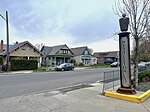Northwest Museum of Arts and Culture
1916 establishments in Washington (state)Art museums and galleries in Washington (state)Art museums established in 1916Buildings and structures in Spokane, WashingtonHistoric house museums in Washington (state) ... and 10 more
History museums in Washington (state)Institutions accredited by the American Alliance of MuseumsKirtland Cutter buildingsMuseums in Spokane County, WashingtonNative American museums in Washington (state)Smithsonian Institution affiliatesTourist attractions in Spokane, WashingtonUnited States art museum and gallery stubsWashington (state) building and structure stubsWestern United States museum stubs

The Northwest Museum of Arts and Culture, formerly the Cheney Cowles Museum and the Pacific Northwest Indian Center, is located in Spokane, Washington's Browne's Addition. It is associated with the Smithsonian Institution, and is accredited by the American Alliance of Museums.
Excerpt from the Wikipedia article Northwest Museum of Arts and Culture (License: CC BY-SA 3.0, Authors, Images).Northwest Museum of Arts and Culture
West 1st Avenue, Spokane
Geographical coordinates (GPS) Address Phone number Website External links Nearby Places Show on map
Geographical coordinates (GPS)
| Latitude | Longitude |
|---|---|
| N 47.65707 ° | E -117.44554 ° |
Address
Northwest Museum of Arts and Culture
West 1st Avenue 2316
99201 Spokane
Washington, United States
Open on Google Maps











